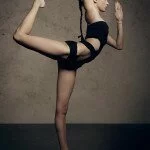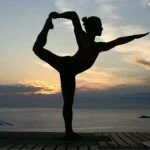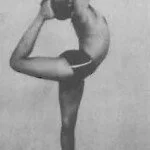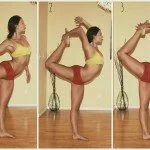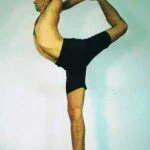Natarajasana (Sanskrit: नटराजासन; IAST: Naṭarājāsana) or Lord of the Dance Pose is an asana.
The name comes from the Sanskrit words nata meaning “dancer”, raja meaning “king” and asana (आसन) meaning “posture” or “seat”.Nataraja is one of the names given to the Hindu God Shiva in his form as the cosmic dancer.
This is a balance asana that strengthens the legs. It also is a full body stretch which engages the shoulders, chest and abdomen, strengthens the thigh and calf muscles, knees and ankles, hips and spine, and develops concentration and grace.
This aesthetic, stretching and balancing asana is used in Indian classical dances.
Step by Step:-
- Stand in Tadasana (Mountain Pose). Inhale, shift your weight onto your right foot, and lift your left heel toward your left buttock as you bend the knee. Press the head of your right thigh bone back, deep into the hip joint, and pull the knee cap up to keep the standing leg straight and strong.
- There are two variations you might try here with your arms and hands. In either case, try to keep your torso relatively upright. The first is to reach back with your left hand and grasp the outside of your left foot or ankle. To avoid compression in your lower back, actively lift your pubis toward your navel, and at the same time, press your tailbone toward the floor.
- Begin to lift your left foot up, away from the floor, and back, away from your torso. Extend the left thigh behind you and parallel to the floor. Stretch your right arm forward, in front of your torso, parallel to the floor.
- The second option with the hands is to sweep your right hand around behind your back and catch hold of the inner left foot. Then sweep the left hand back and grab the outside of the left foot. This variation will challenge your balance even more. Then raise the thigh as described in step 3. This second variation will increase the lift of your chest and the stretch of your shoulders.
- Stay in the pose for 20 to 30 seconds. Then release the grasp on the foot, place the left foot back onto the floor, and repeat for the same length of time on the other side.
Full Pose:-
For the full pose, perform step 1 as described above. Then turn your left arm actively outward (so the palm faces away from the side of the torso), bend the elbow, and grip the outside of the left foot. (You can also grab the big toe with the first two fingers and the thumb.) The fingers will cross the top of the foot, the thumb will press against the sole. Inhale, lift the left leg up, and bring the thigh parallel to the floor. As you do this, rotate the left shoulder in such a way that the bent elbow swings around and up, so that it points toward the ceiling. It requires extreme flexibility to externally rotate and flex the shoulder joint in this way. Reach the right arm straight forward, in front of the torso and parallel to the floor. Hold for 20 to 30 seconds, release, and repeat on the second side for the same length of time.
Anatomical Focus:-
- Thighs
- Knees
- Ankles
- Abdomen
- Pelvis
- Groins
- Chest
- Shoulders
- Spine
- Kidneys
- Lungs
Benefits:-
- Stretches the shoulders and chest
- Stretches the thighs, groins, and abdomen
- Strengthens the legs and ankles
- Improves balance
Contraindications and Cautions:-
Low blood pressure
Beginner’s Tip:-
Many beginners, when lifting the leg, tend to cramp in the back of the thigh. Be sure to keep the ankle of the raised foot flexed; that is, draw the top of the foot toward the shin.
Preparatory Poses:-
- Adho Mukha Vrksasana
- Dhanurasana
- Eka Pada Rajakapotasana
- Gomukhasana
- Hanumanasana
- Supta Virasana
- Supta Padangusthasana
- Urdhva Dhanurasana
- Ustrasana
- Uttanasana
- Virabhadrasana III
- Virabhadrasana I
- Virasana
- Vrksasana
Follow-Up Poses:-
Natarajasana is usually performed as the final pose of a series of challenging backbends. You’ll probably want to release the spine by coming to Ardha Uttanasana (Half Uttanasana), also known as Right Angle Pose, at the wall or reclining twist.
Deepen The Pose:-
You can move even further into this pose by grasping the raised foot with the off-side hand. Complete the pose as described above in the Full Pose section. Then inhale and swing the free hand first up toward the ceiling, then bend the elbow and reach for the inside of the raised foot.

